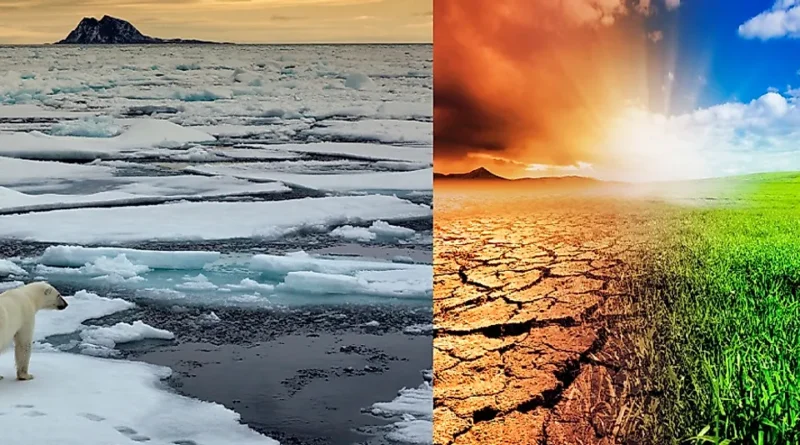How Does Climate Change Affect Global Ecosystems?
Introduction
Climate change is one of the most pressing global challenges of our time. It refers to long-term changes in temperature, precipitation patterns, and other atmospheric conditions, driven primarily by human activities such as the burning of fossil fuels, deforestation, and industrial activities. These changes are not only impacting human societies but are also profoundly affecting global ecosystems. Ecosystems, which are communities of living organisms interacting with each other and their environment, are incredibly sensitive to shifts in climate. As the climate continues to warm, the impacts on biodiversity, species distributions, and the functioning of ecosystems become more pronounced.
In this article, we’ll explore how climate change affects ecosystems worldwide, including the various direct and indirect consequences for biodiversity, habitats, and the overall balance of nature.
1. Rising Temperatures and Heat Stress
One of the most significant impacts of climate change is the rise in global temperatures. Average global temperatures have increased over the past century, and projections show that they will continue to rise. These temperature increases have a direct effect on ecosystems, especially those in sensitive regions such as the Arctic and tropical rainforests.
How It Affects Ecosystems:
- Species Migration: Many species are unable to adapt quickly to rising temperatures and may be forced to migrate to cooler areas. For instance, polar bears are losing their sea ice habitats in the Arctic and are now forced to travel greater distances to find food.
- Heat Stress: Some species, particularly those living in sensitive habitats like coral reefs and high-altitude ecosystems, are facing heat stress, which can lead to death or reduced reproductive success. For example, coral reefs are experiencing bleaching events, where the stress from higher water temperatures causes corals to expel the algae that live within them, resulting in the loss of their vibrant color and essential nutrients.
Tip: Addressing temperature increases requires global efforts to reduce greenhouse gas emissions and limit global warming through climate mitigation strategies.
2. Altered Precipitation Patterns and Droughts
Climate change is also altering precipitation patterns. Some regions are experiencing more frequent and intense rainstorms, while others are facing longer and more severe droughts. This disruption in rainfall patterns affects the availability of freshwater, which is vital for all ecosystems.
How It Affects Ecosystems:
- Water Scarcity: In regions experiencing droughts, water sources for plants and animals may become scarce. This impacts species that rely on specific water sources, such as wetlands, rivers, and lakes.
- Habitat Loss: Many ecosystems, like savannas, wetlands, and temperate forests, are highly dependent on regular rainfall. Altered precipitation patterns can lead to habitat degradation and the loss of species that cannot adapt to these changes.
- Agricultural Disruption: Climate-induced changes in precipitation can also affect human agriculture, which, in turn, impacts species that rely on crops or livestock for food.
Tip: Implementing water conservation measures and sustainable land-use practices can help mitigate the effects of changing precipitation patterns.
3. Melting Ice Caps and Sea Level Rise
As global temperatures rise, the polar ice caps are melting at an alarming rate, contributing to rising sea levels. This phenomenon is particularly concerning for coastal ecosystems and island communities.
How It Affects Ecosystems:
- Coastal Erosion: Rising sea levels are causing the erosion of coastal habitats like mangroves, salt marshes, and beaches, which provide crucial breeding grounds for various species, including sea turtles and shorebirds.
- Loss of Habitat: The melting of sea ice is threatening species such as polar bears, seals, and penguins that rely on the ice for breeding, hunting, and shelter. As the ice melts, these species are forced to move to less suitable areas, putting their survival at risk.
- Ocean Acidification: The increased concentration of carbon dioxide in the atmosphere is also being absorbed by the oceans, causing ocean acidification. This can harm marine life, especially organisms with calcium carbonate shells or skeletons, like coral reefs and shellfish.
Tip: Protecting and restoring coastal habitats and reducing emissions are critical to preventing further damage to these sensitive ecosystems.
4. Disruption of Ecosystem Services
Ecosystems provide essential services that humans rely on, including air and water purification, food production, climate regulation, and disease control. Climate change is disrupting these vital functions, which can have far-reaching consequences for human societies.
How It Affects Ecosystems:
- Biodiversity Loss: Many species are struggling to adapt to rapid environmental changes. The loss of species can reduce biodiversity and weaken ecosystem resilience, making ecosystems less capable of coping with further climate stresses.
- Food Security: Disruptions to ecosystems affect food production. Changes in weather patterns, water availability, and soil health can lead to reduced agricultural yields and the loss of natural food sources.
- Increased Natural Disasters: Ecosystem services like flood control provided by wetlands or forests are diminished as these habitats are degraded. The result can be increased vulnerability to floods, wildfires, and other natural disasters.
Tip: Conservation of biodiversity and the protection of natural ecosystems are vital to maintaining the balance of these ecosystem services.
5. Species Extinction and the Loss of Biodiversity
One of the most concerning consequences of climate change is the threat to biodiversity. Rapid changes in temperature, precipitation, and habitat availability are putting stress on species that may not be able to adapt or migrate quickly enough.
How It Affects Ecosystems:
- Endangered Species: Species with specialized habitat needs, such as the snow leopard, orangutans, or the Siberian tiger, are at higher risk of extinction as their habitats shift or disappear entirely.
- Shifts in Species Distribution: Some species are moving to new areas in response to changing climates. While this may benefit some species, it can disrupt local ecosystems and lead to the introduction of invasive species that outcompete native species.
- Loss of Key Species: The extinction of certain species, especially keystone species (species that have a disproportionately large effect on their ecosystem), can have cascading effects on the entire ecosystem. For example, the decline of pollinators like bees can drastically reduce crop yields and affect entire food chains.
Tip: Conservation efforts, such as habitat protection, wildlife corridors, and sustainable land-use practices, are essential to prevent further species loss.
6. Changes in Ocean Currents and Marine Ecosystems
Ocean currents are influenced by temperature and salinity gradients, and climate change is altering these patterns. Marine ecosystems are particularly vulnerable to these changes, especially those that are highly dependent on stable temperature and nutrient conditions, like coral reefs.
How It Affects Ecosystems:
- Coral Bleaching: Warmer ocean temperatures are causing coral reefs to undergo coral bleaching, which occurs when stressed corals expel the algae that provide them with food and color. This weakens the coral and makes it more susceptible to disease.
- Disruption of Food Chains: Changes in ocean temperatures and currents affect the abundance and distribution of marine species, disrupting the marine food chain. Species that rely on specific water temperatures or nutrient-rich currents may be forced to move or face population declines.
- Fish Migration: Many fish species are moving to cooler waters in search of suitable habitats, which affects fisheries and the livelihoods of people dependent on marine resources.
Tip: Protecting marine environments through marine protected areas and sustainable fishing practices can help safeguard ocean ecosystems.
7. Forests and Wildfires
Forests play a critical role in regulating the climate by absorbing carbon dioxide. However, the changing climate is increasing the frequency and intensity of wildfires, particularly in temperate forests and tropical rainforests.
How It Affects Ecosystems:
- Increased Wildfires: Higher temperatures and prolonged droughts are leading to more frequent and intense wildfires, which destroy large areas of forest and disrupt habitats for numerous species.
- Carbon Emissions: As forests burn, they release the carbon stored in trees back into the atmosphere, further contributing to global warming and climate change.
- Habitat Destruction: Wildfires destroy habitats for many species, including those in the Amazon rainforest, where unique species face extinction due to the destruction of their habitats.
Tip: Forest conservation, controlled burns, and fire management strategies can help reduce wildfire risks and protect forest ecosystems.
Conclusion
Climate change is having profound and widespread effects on global ecosystems, from rising temperatures and changing precipitation patterns to the loss of biodiversity and disrupted ecosystem services. These changes not only threaten the survival of countless species but also affect human societies that depend on these ecosystems for food, water, and climate regulation.
To mitigate the effects of climate change, it is crucial to reduce greenhouse gas emissions, protect vulnerable ecosystems, and promote sustainable practices that preserve biodiversity. Through global cooperation and concerted action, we can help safeguard the planet’s ecosystems for future generations.

